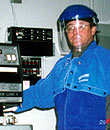|
|
 
|
|
Author
|
Topic: "TIGHT-WRAPPING"
|
|
|
|
|
Rick Long Jr
Expert Film Handler

Posts: 211
From: Toronto, Canada
Registered: Jul 2000
|
 posted 09-02-2001 09:04 PM
posted 09-02-2001 09:04 PM




I've seen this done before. Possible problems are that when you remove the centre ring, the film may collapse inward, making for a messy and scary payout. It may also make the operator a little to overconfident and try to get away without using clamps, which is just nuts. Instead of threading in a "Z" formation I think it would be better to thread up to the first roller as you would normally, then go down under both bottom rollers, then up. I think this way would be easier on both the film and the carraige, as a "Z" formation would put more lateral force on the system than it was designed for. Personnaly, I am a firm believer in using the equipment in the way the manufacturer intended it to be used. More often than not, a shortcut can end up costing you more time in the long run, especially if you drop a print!
| IP: Logged
|
|
|
|
John Pytlak
Film God

Posts: 9987
From: Rochester, NY 14650-1922
Registered: Jan 2000
|
 posted 09-04-2001 02:36 PM
posted 09-04-2001 02:36 PM





Excessive take-up tension can cause an uneven wind or "spoking". If the film has excessive tension over a sprocket, the perforations may be stressed, deformed or damaged. Really high tension may actually "stretch" the film permanently. SMPTE Recommended Practice RP 106 recommends film tension be only 4.4 N (16 ozf) or less, with 1.7 N (6 ozf) being preferred. I second Randy's warning about improper handling of large rolls when moving film between platters. I like to say it is like Russian Roulette --- 5 times out of 6 you get away with it, but the 6th time you have a bloody mess to clean up off the floor.  ------------------
John P. Pytlak, Senior Technical Specialist
Worldwide Technical Services, Entertainment Imaging
Eastman Kodak Company
Research Labs, Building 69, Room 7419
Rochester, New York, 14650-1922 USA
Tel: 716-477-5325 Cell: 716-781-4036 Fax: 716-722-7243
E-Mail: john.pytlak@kodak.com
Web site: http://www.kodak.com/go/motion
| IP: Logged
|
|
Wes Hughes
Expert Film Handler

Posts: 175
From: Raleigh, NC, USA
Registered: Aug 2001
|
 posted 09-04-2001 03:12 PM
posted 09-04-2001 03:12 PM




James: It won't hurt your platter system, but I question why you would need to do this. If your variac rails are clean and properly adjusted, the film should wrap quite tight even when it is threaded normally. I have some Potts and Strong platters that start wrapping loosely sometimes, and it is usually because the variac is sticking a bit, or the rheostat (the current controller that the variac is attached to) has gotten stiff and needs disassembly and cleaning. Also, with the 5-deck the top variac rod can get bumped and get a slight bend in it, and since it is a rod inside another rod it causes the rods to bind and the film to not wrap as tightly. I have never had a platter wrap a film so loosely that it couldn't be moved safely. And on top of that you have the strong hub rings, which lock in the open position and are wonderful for moving prings. Some Speco and Christie rings are terrible. It is interesting that so many here are constantly expounding that it is absolutely terrible to move a print by yourself. While I certainly think that it is a lot better to have someone help you (in most cases), it is not difficult for someone to move an average length print by themselves. You have to realise that, like it or not, it is a fact that theatres are cutting costs. Late on a Thursday night I am sometimes here alone...and only sometimes have one person that stays in the lobby. I move prints here nearly always by myself. I sometimes walk two (one on each shoulder) from one booth to another. In 15 years or so I have not had a problem (except one time that I fell down the stairs, but I am trying to forget about that!) ...BUT, I will not let any member of my staff move a print by themselves...if I drop I lose $$$ and it is MY fault, but with the others it is a different story... interesting thought that I just had...I sometimes think that it is MORE dangerous to move a print with a buddy. It is much safer (IMHO) to carry the print vertically than horizontally, and sometimes in the past when my staff has been moving prints they have dropped them because of lack of coordination in walking, and had dropouts from the center. You cant have that problem carrying a print vertically. Whew...that was a damn long post. Sorry...in a bit of a ramblin' mood today.
| IP: Logged
|
|
|
|
|
|
|
|
|
|
|
|
All times are Central (GMT -6:00)
|
|
Powered by Infopop Corporation
UBB.classicTM
6.3.1.2
The Film-Tech Forums are designed for various members related to the cinema industry to express their opinions, viewpoints and testimonials on various products, services and events based upon speculation, personal knowledge and factual information through use, therefore all views represented here allow no liability upon the publishers of this web site and the owners of said views assume no liability for any ill will resulting from these postings. The posts made here are for educational as well as entertainment purposes and as such anyone viewing this portion of the website must accept these views as statements of the author of that opinion
and agrees to release the authors from any and all liability.
|

 Home
Home
 Products
Products
 Store
Store
 Forum
Forum
 Warehouse
Warehouse
 Contact Us
Contact Us




 Printer-friendly view of this topic
Printer-friendly view of this topic








 )
)







